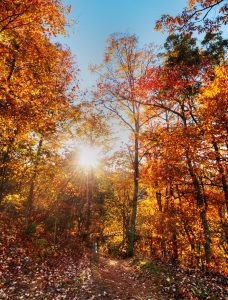
by Lynn and Cele Seldon
Perhaps unlike any other road in the world, the Blue Ridge Parkway in Virginia and North Carolina offers one of the ultimate fall foliage road trips for RVers of all experience levels. It meets all of the prerequisites in resounding fashion: only two lanes of traffic; historical interest; friendly and interesting people; great scenery and fall colors; and many places to stop for the night.
 Since its inception, the Blue Ridge Parkway has been called “America’s Favorite Drive.” It was authorized in the 1930s as a Depression-era public works project, but was a half-century in the making. When completed, it was the nation’s first—and ultimately the longest—rural parkway. It connects the Shenandoah National Park in Virginia (the Skyline Drive) with the Great Smoky Mountains National Park in North Carolina. The total distance is 469 miles, making it an ideal four- or five-day trip in an RV (though it’s appealing to take longer and many RVers do just that come fall).
Since its inception, the Blue Ridge Parkway has been called “America’s Favorite Drive.” It was authorized in the 1930s as a Depression-era public works project, but was a half-century in the making. When completed, it was the nation’s first—and ultimately the longest—rural parkway. It connects the Shenandoah National Park in Virginia (the Skyline Drive) with the Great Smoky Mountains National Park in North Carolina. The total distance is 469 miles, making it an ideal four- or five-day trip in an RV (though it’s appealing to take longer and many RVers do just that come fall).
The Blue Ridge Parkway drive officially starts at Virginia’s Rockfish Gap, where you find the 0 Milepost marker. These markers become the welcome signs of your location on the drive and run progressively each mile southward along the Parkway.
The first major stop is indicative of what the drive has to offer. The Humpback Rocks Visitor Center is often the first taste of the Blue Ridge Parkway for southbound drivers and it’s a great place for an RVer to stop. The visitor centers, camping facilities, and concession system on the Parkway are excellent, with services varying with the season. They offer great places to get maps, ask questions, and learn about campfire talks, nature walks, slide programs, and much more.
The Humpback Rocks area features an interesting self-guided tour through a reconstructed mountain farmstead. The short, but steep, hike up to Humpback Rocks (at Milepost 6.1) is well worth the heavy breathing for a breath-taking view of the area. It’s only 3/4 of a mile to the top.

Back on the Blue Ridge Parkway, the views begin. One of the beauties of RVing is that the driver and passengers generally sit higher than they do in a car, thus providing much better views of the surrounding landscape.
If you stopped at every awe-inspiring view, you’d never make it to the end. There are pull-offs at most of the best overlooks, but you’re also allowed to just pull over on the shoulder as long as your vehicle is completely off the road. The speed limit is 45 miles-per-hour or less and most visitors tend to go slowly. Wooden guard rails subtly protect vehicles and people from the steep drop-offs.
Some possible stops along this stretch include: Ravens Roost, featuring vistas of the Shenandoah River and Torry Mountain); Sherando Lake, a recreational lake in the George Washington National Forest; Whetstone Ridge, which provided the mountain folks with a fine-grained sharpening stone; and Yankee Horse Parking Area, where a hard-riding Union soldier’s horse supposedly fell and had to be shot (there’s now a reconstructed spur of an old logging railroad).
Between Mileposts 58 and 64, Otter Creek runs down the Blue Ridge, following the road to the James River. Otters don’t play along the creek anymore, but lots of people do. This section of the drive features a seasonal campground, a visitor center, a self-guided nature trail, a restored lock and canal system, and the lowest elevation on the entire Parkway (649 feet).
Otter Creek has the first of eight developed campgrounds along the Parkway (if the one you select is closed or full, there are many more just off the road). All of the campgrounds have tent and RV sites (no water or electrical hookups. The campgrounds are generally open from early-May to late-October, depending on the weather. Reservations for some sites are available at www.recreation.gov.
Peaks of Otter, and Rocky Knob are the rest of the Virginia camping options, with the number of RV sites ranging from 24 to 62. In North Carolina, the first option is Doughton Park, followed by Julian Price Memorial Park, Linville Falls, Crabtree Meadows, and Mt. Pisgah (the southernmost and highest elevation campground). One favorite camping spot known by veterans Blue Ridge Parkway RVers is at Doughton Park, where the “Honeymoon Suite” (isolated campsite T9) features colorful sunsets.
 The next stop along the Parkway is popular Peaks of Otter. Along with great camping, the Peaks of Otter area accommodates with some serious hiking to lose a few of the pounds gained cooking gourmet meals in your RV. Head to the Peaks of Otter Visitor Center for a detailed map and information from the very friendly staff (it must be the mountain air). Some good bets are Sharp Top Trail (1.6 steep miles for a 360-degree view); easy Elk Run Loop Trail; strenuous Harkening Hill Loop Trail; Johnson Farm Trail; and Flat Top Trail back to Fallingwater Cascades.
The next stop along the Parkway is popular Peaks of Otter. Along with great camping, the Peaks of Otter area accommodates with some serious hiking to lose a few of the pounds gained cooking gourmet meals in your RV. Head to the Peaks of Otter Visitor Center for a detailed map and information from the very friendly staff (it must be the mountain air). Some good bets are Sharp Top Trail (1.6 steep miles for a 360-degree view); easy Elk Run Loop Trail; strenuous Harkening Hill Loop Trail; Johnson Farm Trail; and Flat Top Trail back to Fallingwater Cascades.
The Parkway continues south and the spectacular views roll by continuously. Look for the Appalachian Trail Overlook around Milepost 100. The famed Appalachian Trail is a 2,100-mile hiking “path” along the ridge of the Appalachian Mountains, stretching from Maine to Georgia. It runs through 14 states and the Virginia section (534 miles) is the longest stretch.
Roanoke is situated very close to the Blue Ridge Parkway and can serve as an ideal stopover if you need a civilization fix. Other quaint stopover towns near the Parkway include Waynesboro, Lexington, Lynchburg, and Galax.
Mabry Mill is just down the road. This often-photographed water-powered mill was operated by E.B. Mabry from 1910 to 1935. The self-guided walking tour includes his gristmill, sawmill, blacksmith shop, and other outdoor exhibits. In the summer and fall, visitors will often find old-time skills being utilized.
Nearby, the Mabry Mill Coffee & Craft Shop offers refreshments and stoneground cornmeal. Just down and off the Parkway, Meadows of Dan offers gas, food, lodging, and shopping, country-style.
The rest of the Virginia portion of the Blue Ridge Parkway is steeped in views, gaps, and history. For more spectacular fall foliage views, pull off at the Groundhog Mountain Parking Overlook, with an observation tower simulating an old tobacco barn. For gaps, head to the quaint town of Fancy Gap. For history check out Puckett Cabin, the home of Orelena Hawks Puckett, a storied local midwife.
The views, gaps, and history don’t stop at the Virginia state line. North Carolina features some spectacular scenery and sightseeing of its own. Some of the most colorful views in the state include Fox Hunters Paradise, Doughton Park, The Lump, Linn Cove Viaduct, Linville Falls, the Mt. Pisgah area, and Richland Balsam Overlook (which, at 6,053 feet, features views from the highest point on the Parkway). Along with these pulloffs, North Carolina hiking options include the Tanawha Trail, the Craggy Gardens area, Graveyard Fields, Devil’s Courthouse, and Waterrock Knob.
 History also abounds in this rugged area. The Cone Manor House and Moses H. Cone Memorial Park provide one of the most interesting stops on the Parkway. This huge and historic estate features old carriage trails that are now ideal for hiking, as well as a well-run Parkway Craft Center, where you can buy crafts and watch occasional demonstrations. Other easy stops for RVers include the fascinating Museum of North Carolina Minerals, the Folk Art Center, and the modern Blue Ridge Parkway Visitor Center and Park Headquarters near Asheville. As with most pull offs along the Parkway, there’s typically easy parking for RVs.
History also abounds in this rugged area. The Cone Manor House and Moses H. Cone Memorial Park provide one of the most interesting stops on the Parkway. This huge and historic estate features old carriage trails that are now ideal for hiking, as well as a well-run Parkway Craft Center, where you can buy crafts and watch occasional demonstrations. Other easy stops for RVers include the fascinating Museum of North Carolina Minerals, the Folk Art Center, and the modern Blue Ridge Parkway Visitor Center and Park Headquarters near Asheville. As with most pull offs along the Parkway, there’s typically easy parking for RVs.
South of Asheville, which is well worth a diversion of one or more days, there are a ton of tunnels (heights are clearly marked) and some of the highest points and pull offs on the Parkway. After Richland Balsam, the drive haltingly descends to 2,020 feet and the end of the Parkway. Just after the end, RVers can head to the Great Smoky Mountains National Park on US 441 and more stunning fall foliage driving.
RESOURCES
The National Park Service website is the best bet for overall Blue Ridge Parkway information: www.nps.gov/blri.
FALL FOLIAGE RVING
An RV offers an ideal way to see fall foliage along the Blue Ridge Parkway and elsewhere. The generally higher vantage point and ease of maneuvering on the Parkway and at pull offs make it popular with RVers. However, because of this popularity with RVers and car drivers, the Parkway can get crowded during peak leaf peeping periods. RVers would do well to time their trips for weekdays, rather than weekends, when the Parkway and campgrounds are much less crowded. It’s also generally less crowded during the end of peak viewing periods, when the crowds have decreased but the colors are just as dramatic.
To plan your next foliage adventure, visit our website, www.thousandtrails.com.

